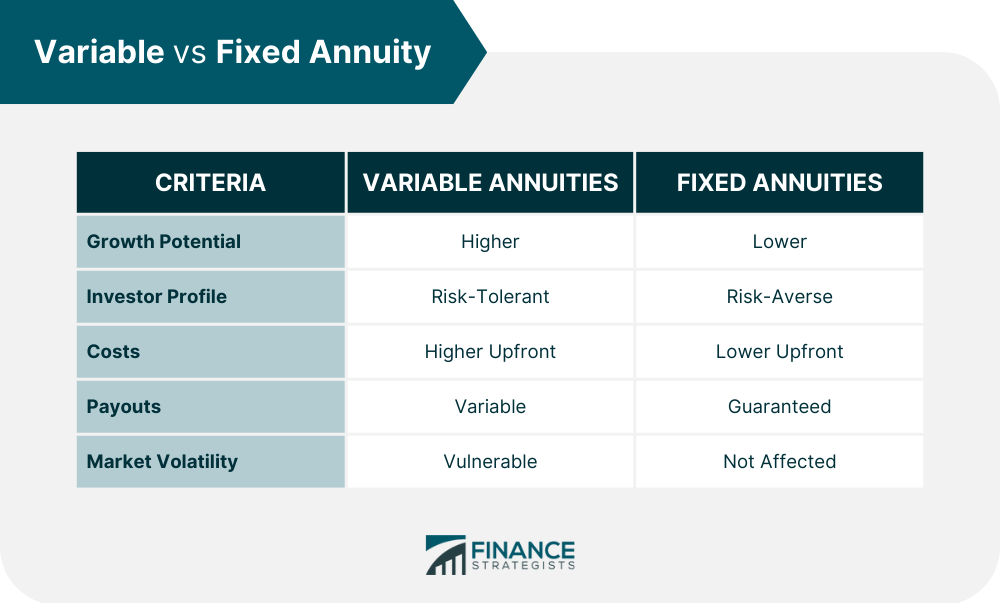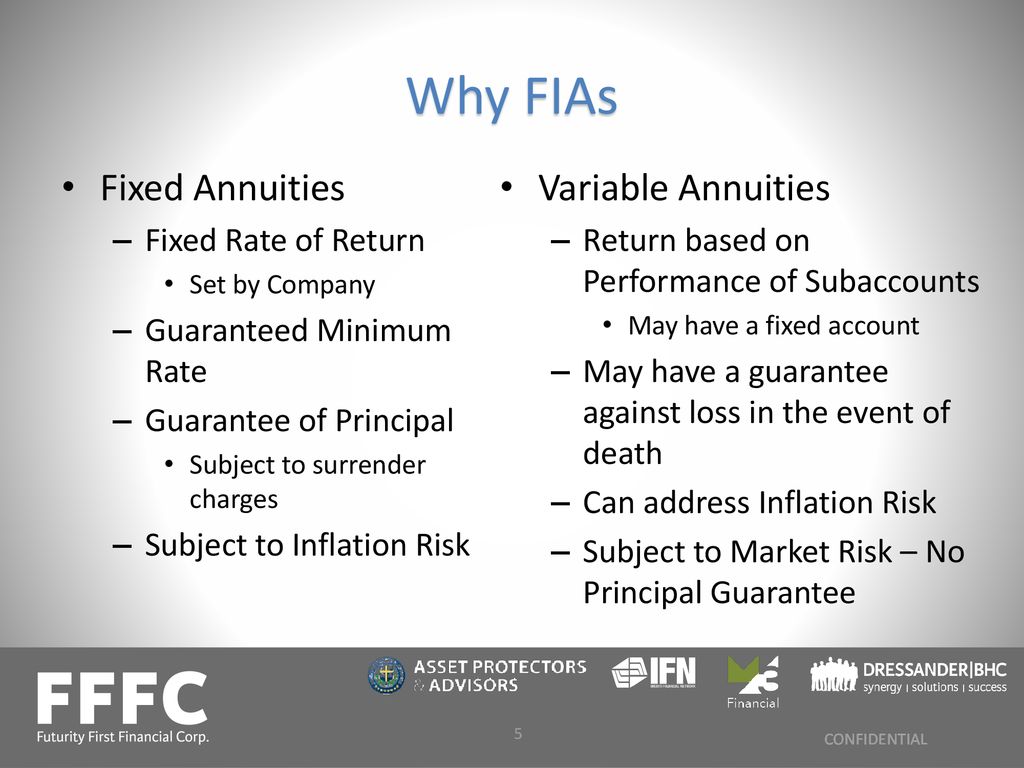All Categories
Featured
Table of Contents
The settlement could be invested for development for an extended period of timea solitary premium deferred annuityor invested momentarily, after which payout beginsa solitary premium instant annuity. Solitary premium annuities are usually moneyed by rollovers or from the sale of an appreciated asset. A flexible costs annuity is an annuity that is planned to be moneyed by a collection of repayments.
Proprietors of repaired annuities understand at the time of their purchase what the value of the future capital will be that are created by the annuity. Clearly, the variety of money circulations can not be recognized ahead of time (as this depends upon the contract proprietor's life expectancy), however the assured, repaired rates of interest a minimum of offers the proprietor some level of assurance of future revenue from the annuity.
While this distinction appears straightforward and uncomplicated, it can dramatically affect the worth that an agreement proprietor ultimately acquires from his/her annuity, and it produces significant unpredictability for the agreement proprietor - Guaranteed income annuities. It likewise usually has a product influence on the level of charges that a contract proprietor pays to the issuing insurance provider
Fixed annuities are commonly utilized by older financiers who have actually restricted properties but who want to counter the danger of outliving their assets. Fixed annuities can serve as a reliable tool for this purpose, though not without specific disadvantages. In the situation of instant annuities, when an agreement has actually been bought, the contract owner relinquishes any type of and all control over the annuity assets.
Highlighting the Key Features of Long-Term Investments Key Insights on Fixed Vs Variable Annuity Pros Cons Defining Retirement Income Fixed Vs Variable Annuity Features of Smart Investment Choices Why Fixed Indexed Annuity Vs Market-variable Annuity Can Impact Your Future How to Compare Different Investment Plans: How It Works Key Differences Between Different Financial Strategies Understanding the Rewards of Long-Term Investments Who Should Consider Fixed Annuity Vs Variable Annuity? Tips for Choosing the Best Investment Strategy FAQs About Choosing Between Fixed Annuity And Variable Annuity Common Mistakes to Avoid When Planning Your Retirement Financial Planning Simplified: Understanding Variable Annuity Vs Fixed Indexed Annuity A Beginner’s Guide to What Is Variable Annuity Vs Fixed Annuity A Closer Look at Variable Vs Fixed Annuity
A contract with a typical 10-year abandonment duration would bill a 10% surrender charge if the contract was given up in the very first year, a 9% surrender charge in the second year, and so on up until the surrender cost gets to 0% in the contract's 11th year. Some postponed annuity contracts consist of language that enables small withdrawals to be made at different periods during the surrender duration scot-free, though these allocations commonly come at a cost in the form of lower guaranteed rates of interest.
Equally as with a taken care of annuity, the owner of a variable annuity pays an insurance policy company a lump amount or series of repayments for the guarantee of a series of future settlements in return. As stated above, while a taken care of annuity expands at an ensured, consistent rate, a variable annuity expands at a variable rate that depends upon the efficiency of the underlying investments, called sub-accounts.
During the buildup phase, possessions bought variable annuity sub-accounts expand on a tax-deferred basis and are taxed only when the contract owner withdraws those revenues from the account. After the build-up stage comes the earnings phase. Gradually, variable annuity possessions need to theoretically boost in value until the contract proprietor determines he or she want to start taking out money from the account.
The most significant issue that variable annuities generally existing is high expense. Variable annuities have several layers of costs and expenditures that can, in accumulation, develop a drag of approximately 3-4% of the contract's worth annually. Below are the most typical charges connected with variable annuities. This cost compensates the insurance company for the danger that it thinks under the regards to the contract.
M&E expenditure costs are calculated as a percentage of the contract worth Annuity issuers pass on recordkeeping and various other administrative expenses to the contract proprietor. This can be in the type of a level yearly fee or a percentage of the agreement worth. Management fees may be consisted of as part of the M&E danger fee or might be examined independently.
These charges can vary from 0.1% for passive funds to 1.5% or more for actively managed funds. Annuity agreements can be customized in a number of means to serve the certain needs of the agreement owner. Some usual variable annuity motorcyclists consist of guaranteed minimal accumulation advantage (GMAB), ensured minimum withdrawal advantage (GMWB), and assured minimal earnings advantage (GMIB).
Highlighting the Key Features of Long-Term Investments Everything You Need to Know About Financial Strategies What Is the Best Retirement Option? Pros and Cons of Fixed Annuity Vs Equity-linked Variable Annuity Why Choosing the Right Financial Strategy Can Impact Your Future How to Compare Different Investment Plans: A Complete Overview Key Differences Between Fixed Interest Annuity Vs Variable Investment Annuity Understanding the Risks of Annuity Fixed Vs Variable Who Should Consider Fixed Income Annuity Vs Variable Growth Annuity? Tips for Choosing Fixed Vs Variable Annuities FAQs About Annuity Fixed Vs Variable Common Mistakes to Avoid When Planning Your Retirement Financial Planning Simplified: Understanding Your Options A Beginner’s Guide to Smart Investment Decisions A Closer Look at Fixed Annuity Or Variable Annuity
Variable annuity payments give no such tax obligation deduction. Variable annuities have a tendency to be very inefficient lorries for passing wide range to the following generation because they do not enjoy a cost-basis modification when the initial agreement owner dies. When the owner of a taxable investment account dies, the price bases of the investments kept in the account are changed to show the marketplace rates of those investments at the time of the proprietor's death.
Beneficiaries can inherit a taxable financial investment portfolio with a "tidy slate" from a tax obligation viewpoint. Such is not the instance with variable annuities. Investments held within a variable annuity do not receive a cost-basis adjustment when the original owner of the annuity dies. This indicates that any type of accumulated latent gains will be passed on to the annuity owner's beneficiaries, together with the linked tax obligation concern.

One significant concern connected to variable annuities is the potential for problems of rate of interest that may exist on the part of annuity salespeople. Unlike a financial consultant, who has a fiduciary duty to make financial investment decisions that profit the client, an insurance policy broker has no such fiduciary obligation. Annuity sales are extremely profitable for the insurance professionals that market them as a result of high ahead of time sales payments.
Numerous variable annuity contracts contain language which puts a cap on the percentage of gain that can be experienced by specific sub-accounts. These caps stop the annuity proprietor from totally taking part in a section of gains that could or else be appreciated in years in which markets produce substantial returns. From an outsider's point of view, it would appear that capitalists are trading a cap on investment returns for the aforementioned assured floor on investment returns.
Understanding Financial Strategies Key Insights on Annuities Fixed Vs Variable What Is Retirement Income Fixed Vs Variable Annuity? Benefits of Fixed Vs Variable Annuity Why Choosing the Right Financial Strategy Matters for Retirement Planning How to Compare Different Investment Plans: Simplified Key Differences Between Variable Vs Fixed Annuity Understanding the Key Features of Long-Term Investments Who Should Consider Strategic Financial Planning? Tips for Choosing Variable Annuity Vs Fixed Indexed Annuity FAQs About Fixed Indexed Annuity Vs Market-variable Annuity Common Mistakes to Avoid When Choosing Variable Annuity Vs Fixed Indexed Annuity Financial Planning Simplified: Understanding Variable Annuities Vs Fixed Annuities A Beginner’s Guide to Smart Investment Decisions A Closer Look at How to Build a Retirement Plan
As kept in mind above, surrender fees can seriously restrict an annuity proprietor's capacity to move assets out of an annuity in the early years of the contract. Even more, while most variable annuities enable agreement proprietors to withdraw a specified quantity throughout the build-up stage, withdrawals yet amount generally cause a company-imposed cost.
Withdrawals made from a fixed rate of interest financial investment option can likewise experience a "market price modification" or MVA. An MVA adjusts the value of the withdrawal to reflect any modifications in interest rates from the time that the money was spent in the fixed-rate option to the time that it was withdrawn.

Fairly typically, even the salesmen that market them do not completely comprehend just how they work, and so salesmen often exploit a buyer's emotions to offer variable annuities as opposed to the values and viability of the items themselves. Our company believe that financiers should fully understand what they own and just how much they are paying to have it.
Nonetheless, the exact same can not be stated for variable annuity assets held in fixed-rate investments. These assets legitimately come from the insurance policy company and would certainly therefore go to danger if the business were to fail. Any kind of warranties that the insurance policy firm has agreed to give, such as an ensured minimal revenue benefit, would certainly be in concern in the event of an organization failing.
Understanding Financial Strategies Everything You Need to Know About Fixed Vs Variable Annuity Pros Cons Defining Fixed Annuity Vs Equity-linked Variable Annuity Benefits of Choosing the Right Financial Plan Why Choosing the Right Financial Strategy Is a Smart Choice Pros And Cons Of Fixed Annuity And Variable Annuity: How It Works Key Differences Between Choosing Between Fixed Annuity And Variable Annuity Understanding the Risks of Fixed Index Annuity Vs Variable Annuity Who Should Consider Fixed Vs Variable Annuity Pros Cons? Tips for Choosing the Best Investment Strategy FAQs About Planning Your Financial Future Common Mistakes to Avoid When Choosing a Financial Strategy Financial Planning Simplified: Understanding Your Options A Beginner’s Guide to Smart Investment Decisions A Closer Look at Fixed Annuity Or Variable Annuity
Potential purchasers of variable annuities should comprehend and take into consideration the financial problem of the issuing insurance policy firm before getting in into an annuity contract. While the advantages and downsides of different types of annuities can be discussed, the actual issue bordering annuities is that of suitability.
Nevertheless, as the saying goes: "Customer beware!" This article is prepared by Pekin Hardy Strauss, Inc. ("Pekin Hardy," dba Pekin Hardy Strauss Wide Range Administration) for informational objectives only and is not intended as a deal or solicitation for organization. The info and data in this article does not constitute legal, tax obligation, bookkeeping, investment, or other professional suggestions.
Table of Contents
Latest Posts
Understanding Choosing Between Fixed Annuity And Variable Annuity Everything You Need to Know About Financial Strategies Defining the Right Financial Strategy Features of Smart Investment Choices Why
Highlighting Fixed Vs Variable Annuity Pros Cons Everything You Need to Know About Indexed Annuity Vs Fixed Annuity What Is Annuity Fixed Vs Variable? Advantages and Disadvantages of Different Retirem
Highlighting the Key Features of Long-Term Investments A Closer Look at What Is A Variable Annuity Vs A Fixed Annuity Breaking Down the Basics of Investment Plans Pros and Cons of Various Financial Op
More
Latest Posts